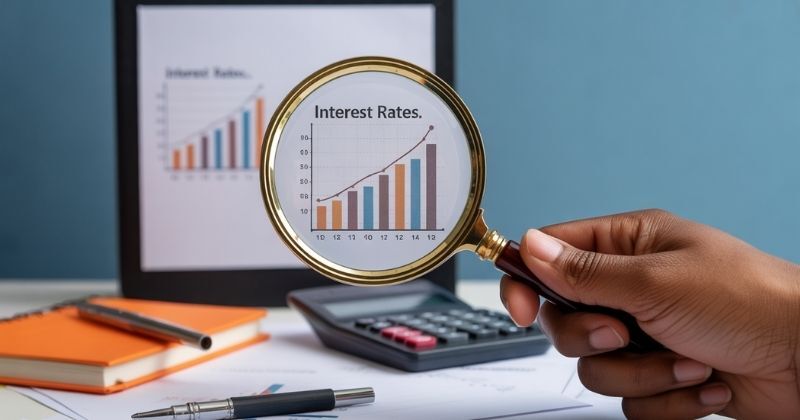
Inflation expectations across South Africa have dropped to an unprecedented low, yet the prospect of a much-anticipated interest rate cut still appears to be out of immediate reach for households and businesses. This latest development has sparked cautious optimism across financial markets, with many analysts suggesting that the economy may be entering a more stable period after years of price volatility. The latest findings have sparked cautious optimism, but monetary policy decisions may not shift as quickly as many had hoped. Consumers and businesses are now waiting anxiously for signs of relief from high borrowing costs that have weighed heavily on spending and investment.
Key Takeaways
- Inflation Expectations Hit Record Low: South Africa’s long-term inflation expectations have dropped to a historic low of 4.2%, with forecasts for 2027 at their lowest level in two decades. This signals that price pressures are easing and could provide room for future interest rate cuts if other economic indicators align.
- Interest Rate Cuts Remain Uncertain: Despite the favourable inflation outlook, economists from Nedbank and Absa believe the Monetary Policy Committee is unlikely to cut rates at its next meeting, as the SARB is still focused on bringing inflation closer to its 3% target. Markets, however, are pricing in potential cuts later in the year, particularly if global conditions support a looser stance.
- Economic Growth and Wage Forecasts Trimmed: Survey participants lowered wage growth and GDP expectations slightly, now anticipating just 0.8% growth for 2024. This subdued outlook highlights the need for pro-growth policies and may strengthen the case for lower interest rates in the medium term to stimulate economic activity.
About Arcadia Finance
Arcadia Finance makes borrowing stress-free. With no application fees and access to 19 NCR-compliant lenders, you can compare safe, reputable options in minutes. The streamlined process ensures you find the right loan tailored to your budget and goals.
BER Survey Shows Sharp Decline in Expectations
The Bureau for Economic Research (BER) recently released the results of its latest inflation expectations survey, revealing that analysts, business leaders, and trade unions have all collectively revised their longer-term outlook for inflation downwards. This adjustment indicates a growing confidence that price growth will remain under control over the next few years. The BER survey is widely regarded as a key barometer of economic sentiment, and this sharp downward shift may influence investor behaviour and interest rate forecasts.

Long-Term Inflation Outlook Falls to Historic Levels
Respondents in the survey now expect headline inflation over the next five years to average 4.2%, which is a decline of 0.2 percentage points compared with the second quarter’s projection. This figure also represents the lowest level recorded since the BER began tracking such data. This milestone signals a growing belief that inflationary pressures are moderating and could stay anchored for a prolonged period, potentially giving the Reserve Bank more room to ease policy in the future. Expectations for 2027 were also revised downwards by 0.3 percentage points to 4.2%, a milestone that marks the lowest figure in two decades. Such a low reading is particularly significant given the persistent inflationary environment of recent years, which placed heavy pressure on consumers’ disposable income.
Short-Term Projections Also Adjusted
Shorter-term forecasts followed the same trend, with respondents cutting their expectations for headline inflation in 2025 and 2026 by 0.1 percentage points each. The updated figures now stand at 3.8% for 2025 and 4.2% for 2026, signalling confidence that inflation will remain close to the lower end of the target band.
These revisions could influence market pricing for interest rate cuts and might encourage businesses to revise their investment plans in anticipation of a more favourable lending environment.
The survey’s outcome is one of several indicators carefully evaluated by the Monetary Policy Committee (MPC) of the South African Reserve Bank (SARB) when deciding on interest rate adjustments. The MPC generally becomes more cautious when inflation expectations rise significantly, particularly when they remain well above the lower end of the official target range of 3% to 6% or when other indicators start to show signs of deterioration. Given that the SARB has faced criticism in the past for holding rates too high for too long, there will be significant public interest in how it responds to these improved inflation numbers.
Link Between Inflation and Wages
If inflation expectations were to climb, the result could be an increase in wage demands as workers seek to protect their income from eroding purchasing power. Businesses may also respond by raising prices further if consumer demand remains strong enough to absorb the increase. In such cases, the Reserve Bank might be compelled to raise interest rates to keep inflation expectations anchored and prevent a sustained increase in actual inflation. The interaction between wage growth and price increases has been a key driver of inflationary cycles in South Africa in the past, making this metric closely watched by policymakers.
The opposite effect is now in play, with expectations and other economic indicators pointing downwards. This trend could provide the MPC with more space to consider easing monetary policy, although there is still some uncertainty regarding the timing and extent of any potential cuts. Financial markets are now pricing in the possibility of a rate cut later this year, although much will depend on global economic conditions, particularly decisions by the US Federal Reserve.

SARB Governor Highlights 3% Target Preference
The trajectory of interest rates remains somewhat unclear, with SARB Governor Lesetja Kganyago signalling that the MPC aims to bring inflation closer to 3% over time. While this still falls within the formal 3% to 6% target range, it is considerably lower than the 4.5% midpoint that has historically served as the benchmark for rate decisions. This figure is also slightly below the most recent July inflation reading of 3.5%.
This stricter stance suggests that the SARB is determined to entrench a low-inflation environment, even if it means keeping rates higher for longer in the short term.
Any move to officially lower the inflation target would require the approval of the Minister of Finance, Enoch Godongwana. At this stage, no formal announcement has been made regarding a change to the target range, which leaves monetary policy strategy in a transitional phase. Market participants are watching closely for any indication from the National Treasury, as a formal shift in the target could reshape interest rate expectations across the economy.
Upcoming MPC Meeting Could Provide Clues
Although the downward trend in inflation expectations is clear, it remains uncertain whether this will be enough to trigger a rate cut at the next MPC meeting scheduled for this week. The BER highlighted that long-term inflation expectations have been steadily declining since the start of 2024, reinforcing the case for monetary easing at some point. Economists suggest that the upcoming decision will be one of the most closely watched in years, as it may signal the start of a more accommodative cycle after an extended period of tight monetary policy.
Despite this positive development, economists from Nedbank and Absa have stated that they do not anticipate an immediate rate cut this week, given the SARB’s cautious stance and its focus on achieving the 3% target. In contrast, Investec’s Chief Economist Annabel Bishop suggests that a cut could be implemented as soon as September or November, influenced partly by the aggressive rate-cutting cycle currently under way in the United States. This divergence of opinion underscores the uncertainty that still surrounds South Africa’s monetary policy outlook, leaving businesses and consumers in a wait-and-see mode.
Potential for Lower Rates in the Medium-Term
There is broad consensus among economists that a sustained decline in the inflation target could pave the way for lower interest rates over the medium to long term, potentially providing relief for indebted households and businesses.
Lower borrowing costs could also boost consumer spending and help stimulate economic growth, which has been sluggish in recent years.
A closer look at the BER data shows that analysts and trade union officials made similar downward revisions to their expectations. Analysts now project a five-year average inflation rate of 3.6%, while trade unions forecast a slightly higher figure of 4.3%. Interestingly, business leaders chose to maintain their previous projections for both 2027 and the five-year average, keeping their expectations steady at 4.5%. This split among the social groups suggests that some sectors remain cautious, potentially due to lingering risks such as global commodity price volatility and local energy constraints.
Short-Term Revisions Across All Groups
In terms of the near-term forecast, all three groups made modest downward revisions, with analysts expecting inflation at 3.9% next year, business leaders predicting 4.4%, and trade unions forecasting 4.2%. Household expectations, by contrast, showed very little movement, remaining steady at 5.5% for the one-year outlook between the second and third quarters. This stability in household expectations could reflect the impact of high food, transport, and utility costs that continue to dominate household budgets.
Respondents also trimmed their wage growth forecasts, now anticipating salary increases of 4.7% in 2024 and 4.8% in 2025, slightly lower than the previous expectations of 4.9% and 5.1%. Similarly, economic growth expectations eased slightly across the three main social groups, though the decline was less pronounced than in earlier surveys. On average, respondents now expect GDP growth of 0.8% this year, rising to 1.2% next year, reflecting only a marginal change from previous estimates. This subdued growth outlook reinforces the need for pro-growth measures alongside monetary policy adjustments to support a more sustainable recovery.
Conclusion
South Africa’s record-low inflation expectations present a promising backdrop for potential interest rate relief, but the timing of any cuts remains uncertain as the SARB continues to prioritise its 3% target. While declining inflation and moderate wage pressures suggest a more stable environment ahead, the central bank’s cautious stance means that households and businesses may need to endure high borrowing costs for a little longer before meaningful relief arrives.
Fast, uncomplicated, and trustworthy loan comparisons
At Arcadia Finance, you can compare loan offers from multiple lenders with no obligation and free of charge. Get a clear overview of your options and choose the best deal for you.
Fill out our form today to easily compare interest rates from 19 banks and find the right loan for you.



